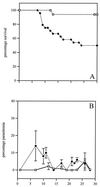Innate resistance to Babesia infection is influenced by genetic background and gender
- PMID: 11705985
- PMCID: PMC98899
- DOI: 10.1128/IAI.69.12.7955-7958.2001
Innate resistance to Babesia infection is influenced by genetic background and gender
Abstract
Infection of severe combined immunodeficient mice with Babesia sp. strain WA1 was studied to assess the contributions of innate and adaptive immunity in resistance to acute babesiosis. The scid mutation showed little effect in genetically susceptible C3H mice and did not decrease the inherent resistance of C57BL/6 mice to the infection, suggesting that innate immunity plays a central role in determining the course of Babesia infection in these strains. In contrast, the scid mutation dramatically impaired resistance in moderately susceptible BALB/c mice, suggesting that acquired immunity may play an important secondary role. In comparison to their female counterparts, male mice of different genetic backgrounds showed increased resistance to the infection, indicating that the gender of the host may influence protection against babesiosis.
Figures




References
-
- Alexander J, Stimson W H. Sex hormones and the course of parasitic infection. Parasitol Today. 1988;4:189–193.
-
- Alexander J. Sex differences and cross-immunity in DBA/2 mice infected with L. mexicana and L. major. Parasitology. 1988;96:297–302. - PubMed
-
- Bancroft G J, Kelly J P, Kaye P M, McDonald V, Cross C. Pathways of macrophage activation and innate immunity. Immunol Lett. 1994;43:67–70. - PubMed
-
- Beebe A M, Mauze S, Schork N J, Coffman R L. Serial backcross mapping of multiple loci associated with resistance to Leishmania major in mice. Immunity. 1997;6:551–557. - PubMed
Publication types
MeSH terms
Grants and funding
LinkOut - more resources
Full Text Sources

